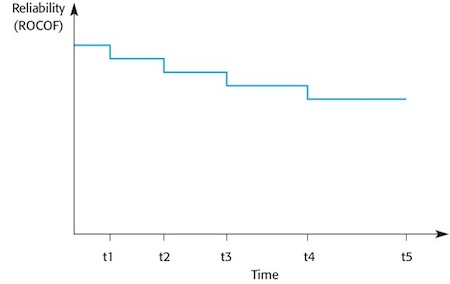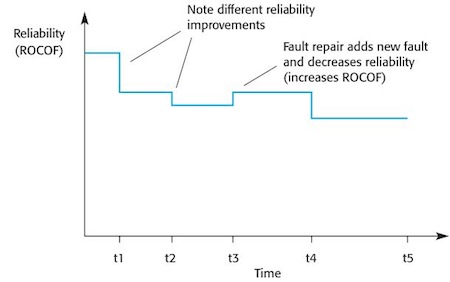
There are various reliability growth models that have been derived from reliability experiments in a number of different application domains. As Kan (Kan, 2003) discusses, most of these models are exponential, with reliability increasing quickly as defects are discovered and removed. The increase then tails off and reaches a plateau as fewer and fewer defects are discovered and removed in the later stages of testing.
The simplest model that illustrates the concept of reliability growth is a step function model (Jelinski and Moranda, 1972). The reliability increases by a constant increment each time a fault (or a set of faults) is discovered and repaired (Figure 1) and a new version of the software is created. This model assumes that software repairs are always correctly implemented so that the number of software faults and associated failures decreases in each new version of the system. As repairs are made, the rate of occurrence of software failures (ROCOF) should therefore decrease, as shown in Figure 1. Note that the time periods on the horizontal axis reflect the time between releases of the system for testing so they are normally of unequal length.

Figure 1 Equal-step function model of reliability growth
In practice, however, software faults are not always fixed during debugging and when you change a program, you sometimes introduce new faults into it. The probability of occurrence of these faults may be higher than the occurrence probability of the fault that has been repaired. Therefore, the system reliability may sometimes worsen in a new release rather than improve.
The simple equal-step reliability growth model also assumes that all faults contribute equally to reliability and that each fault repair contributes the same amount of reliability growth. However, not all faults are equally probable. Repairing the most common faults contributes more to reliability growth than does repairing faults that occur only occasionally. You are also likely to find these probable faults early in the testing process, so reliability may increase more than when later, less probable, faults are discovered.
Later models, such as that suggested by Littlewood and Verrall (Littlewood and Verrall, 1973) take these problems into account by introducing a random element into the reliability growth improvement effected by a software repair. Thus, each repair does not result in an equal amount of reliability improvement but varies depending on the random perturbation (Figure 2).
Littlewood and Verrall’s model allows for negative reliability growth when a software repair introduces further errors. It also models the fact that as faults are repaired, the average improvement in reliability per repair decreases. The reason for this is that the most probable faults are likely to be discovered early in the testing process. Repairing these contributes most to reliability growth.

Figure 2 Random-step function model of reliability growth
The above models are discrete models that reflect incremental reliability growth. When a new version of the software with repaired faults is delivered for testing it should have a lower rate of failure occurrence than the previous version. However, to predict the reliability that will be achieved after a given amount of testing continuous mathematical models are needed. Many models, derived from different application domains, have been proposed and compared (Littlewood, 1990).